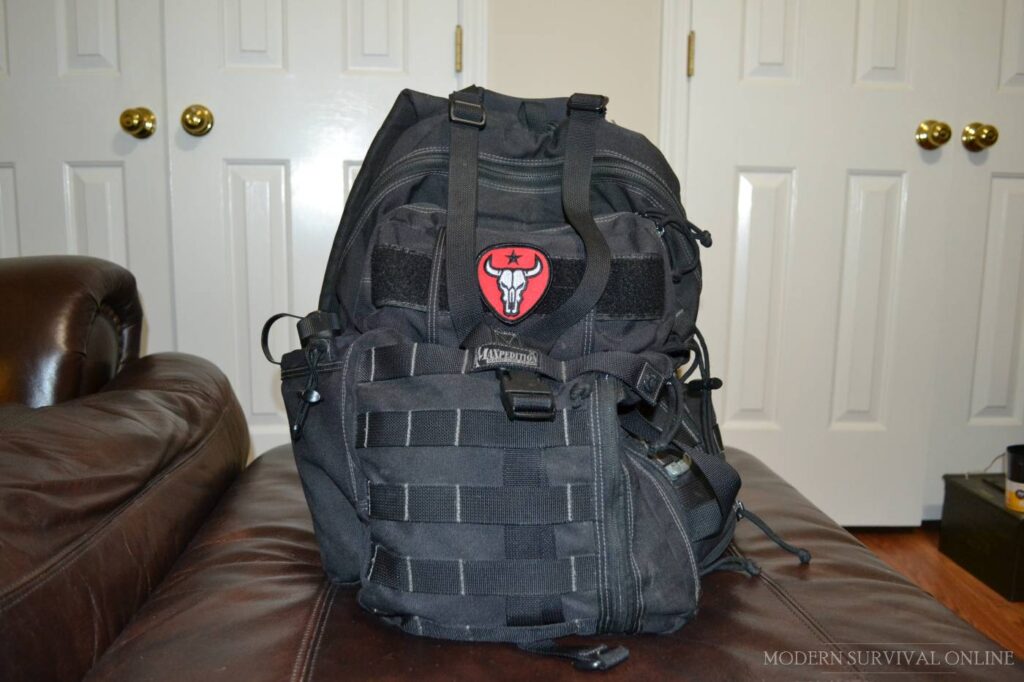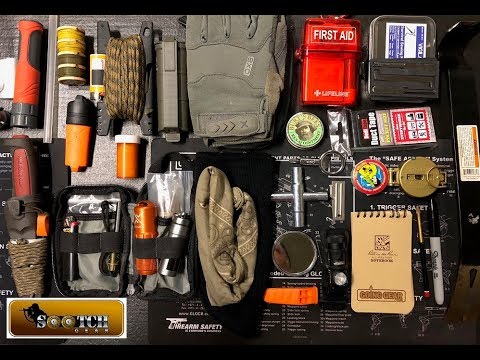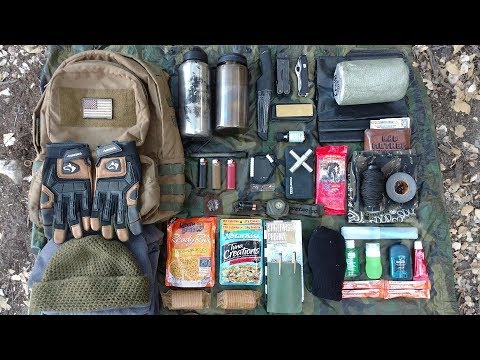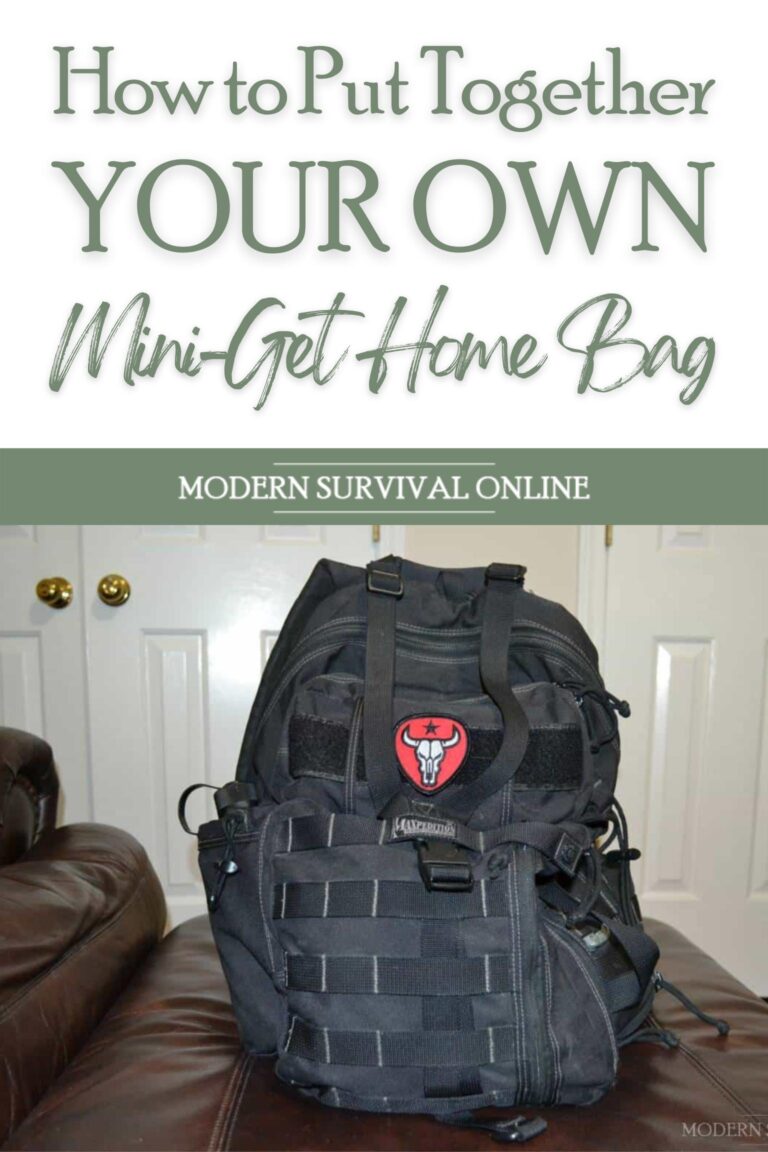If you have been prepping for any length of time, or even reading up on prepping as a lifestyle change, you are likely already familiar with that one piece of gear that all preppers love: the BOB, that backpack full of goodies that you will rely on to get you and yours to safer ground when disaster strikes and you are forced to hit the road.

But there is another piece of gear, indeed another piece of survival luggage, that you are probably not so familiar with: the GHB.
The get-home bag is often thought of as just a smaller BOB, but that is not quite true as the GHB has a separate yet extremely important role to play for most folks.
Have you ever stopped to consider how many of your waking hours you spend away from home, whether at work, for recreation, or for any of the other countless tasks?
You had better start considering it, because the average adult spends an awful lot of time away from home, the very home where you have your precious BOB and all your other survival gear stashed.
Getting caught out without your BOB or any other gear when you are far from home could prove disastrous and see you stranded just when you need to get home, take stock and then get rolling as quickly as possible.
The get-home bag will help you do that, and in this article we’re going to provide you with information and hard-hitting advice necessary to put together a small, svelte, and extremely capable GHB.

What is a Get-Home Bag for?
The get-home bag is a specialized piece of survival gear, similar in composition and in principle to the bug-out bag, but distinctly different because of its intended role, in particular the context in which it will be used.
Where the typical BOB is a large and in-charge everything-but-the-kitchen-sink survival pack that is designed for heavy sustainment during a sometimes long transit to a rendezvous point the GHB is the opposite.
A good GHB should be small, sparse, and loaded only with the things that you must have in order to facilitate a rapid flight home when you have the misfortune to be away when the shit hits the fan.
You might not have considered this scenario prior to cracking open this article:
What if, in order to properly tackle an emergency situation, you must first get yourself home, round up your family members (if you have any), grab your gear, assess the situation, and then depart for a bug-out location, if called for.
What would you do if you are starting from your workplace, a different city, or some other remote location with hardly any of the gear you have worked so hard to accumulate?
Chances are making a good go of it begins with heading home first, not just dropping everything and heading for the hills with whatever you have in your pockets. The GHB is tailor-made to equip you for this possibility.
Unfortunately, quite a few preppers overlook or disregard the GHB as a concept entirely, thinking that it is just another “flavor” of BOB or a waste of their time, money, and energy.
Apparently, already having a BOB in place as part of their preps somehow mitigates the need for a GHB.
Folks I have talked to that feel this way seem to think that if they are able to perceive, somehow, that trouble is likely, they will just toss their BOB in the car and take it with them. This is understandable, but misguided.
Sometimes Getting Home is the First Step
First of all, if you or anyone could perceive the fact, with certainty, that trouble was on the horizon, you probably wouldn’t go to work at all.
In fact, you would probably just stay home and batten down the hatches with your family close by and your BOB at the ready for a quick departure! Sadly, life just doesn’t work that way.
One should also consider that loved ones, family members and other folks we care about are unlikely to just be at home, kicking around, waiting for things to go bad so they can enact the plan you have doubtlessly rehearsed with them time and time again. It is possible, just not likely.
Your spouse or partner probably has a job and activities of their own that will take them away from home. Kids have school, sports, and other engagements.
There are countless reasons why they won’t be at home at any given time when trouble strikes, the same as you.
Do you want to know what they will in all likelihood be doing once that self-same trouble occurs? You got it; they are heading for home also!
So now you are faced with a situation where making your way home despite the circumstances, despite any threats out there, at the best conceivable speed is paramount.
If you are blessedly lucky you might be able to take your vehicle or another one, but chances are you’ll be hoofing it.
In these circumstances do you want to be toting a humongous 40, 50, or even 60 pound bug-out bag when speed is of the essence and you aren’t going that far? I don’t, either!
This is exactly why you need a GHB.
Personal Factors Affecting Your GHB
Though all of the concepts inherent to prepping are more or less universal across a great variety of lifeways, there is no genuinely one size fits all solution for equipping yourself to deal with various emergencies, disasters, and society-toppling catastrophes.
Every single one of us has our own special requirements, informed by our life choices, our condition, and many other factors. Our personal situation or context, should help us determine precisely what is needed for us.
Consider the following variables before you go and smash together a GHB willy-nilly:
Your Job and “Office”
Before you pick out your pack and equip it to create your GHB, we need to assess where it is going.
In other words, what is your workplace environment like? What do you do for a living and what is your position?
A crowded office or cubicle environment will necessitate your bag to remain more or less close at hand if you don’t have lockers to store it in safely.
Certain work environments will preclude you from bringing any outside luggage in with you entirely.
In short, how many “waves” is it going to make if you bring your GHB into work with you? If this will prove problematic, you might need to leave it in your vehicle.
Your Coworkers
Considering the people you work with, what are they like? Is there an expectation that you or others could bring in luggage with them, be it backpacks, messenger bags, or something else?
Do your coworkers respect boundaries or are they nosy? If they were to discover something sensitive or perhaps worthy of investigation would they report it to your boss immediately?
Nosy people can make life complicated for you, especially concerning the contents of your GHB, and double-especially if you have weapons in it.
How You Get to Work
How you commute to and from work is also going to have an impact on carriage of your get-home bag.
If you drive yourself in a personally owned vehicle, at the very least you can keep your bag in your car, truck or SUV.
If you carpool, you’ll need to consider how many eyebrows will be raised by the presence of the bag among your fellow rideshares. See the section previously on coworkers.
However, depending on where you live commuting via mass transit could provide plenty of cover for your luggage or subject you to additional scrutiny.
It all depends on your fellow riders, your local regulations and the service provider. Once again, you do not want to draw unwanted attention to yourself!
Keeping all of these factors in mind and providing answers to the questions will better equip you for both bag selection and outfitting the contents.
Choosing the Right Bag for the Job
The core component of your GHB is naturally the pack itself. Anybody who has put a BOB together will already be old hat at this process, but it is worth mentioning that prime considerations are different for a GHB than they are for a BOB.
For one, we place a premium on compact size, styling and colorway features that will help the bag blend in wherever we take it. Staying low profile while holding everything we need is crucial.
Ruggedness is still important, but less so than it would be normally when considering a BOB, because under no circumstances should your small GHB be loaded anywhere nearly as heavily as your average BOB.
Just like we did above, keep these considerations in mind when selecting your pack:
Size
Remember, you want to keep your mini-GHB as small and as compact as possible, obviously. You’re trying to carry only what you absolutely require in order to make it home, and nothing else.
The small, lean profile of a mini GHB will lend itself towards speed, agility and energy economy when you are moving quickly.
Don’t give in to the idea that you’ll get a pack that is a little bit larger than what you need, because the temptation to fill that extra space will be strong and before you know it your pack is getting too heavy.
Style, Color, Materials
Depending on your environment and workplace your style, material and color choices might matter a whole lot or hardly at all.
The more your GHB will be exposed to notice the more seamlessly it needs to blend in to whatever environment it is a part of.
If you work in an upscale office and are hauling in a military or college-styled backpack, you’re going to raise some eyebrows, or at the very least commit a social faux pas.
Conversely, a fine leather satchel in a hard scrabble, hard-working trade job environment will be conspicuously out of place. Now is the time for blending in, not expressing yourself.
Strength
Just because your mini-GHB has a much easier job than an equivalent BOB does not mean you can totally skip on quality of construction!
There is still going to be a fair bit of weight in this pack, and more germane to the topic at hand it will be subjected to rigorous use, including being dragged, snatched, snagged, jostled and tossed in all weather conditions.
A lesser pack that blows out a strap or busts a panel will be a major problem, so ensure that your pack is built to the correct standard for its category.
Protection
Because we and our pack are going to be exposed to the elements it is a good thing if the pack can provide a certain amount of protection for the contents within.
Your pack does not have to be truly waterproof, because we can waterproof it using anything from a rain fly to a trash bag if we have to, but your pack should not be made of a material that is going to wick up water and allow it to soak the items you have stored within.
See? Nothing to it. So long as you keep these few selection criteria in mind I have no doubt that you’ll pick out an excellent basis for your mini-GHB.

Picking the Right Gear for your Get-Home Bag
Now we get to the fun part for most preppers: Picking out the supplies, gear and equipment you’ll stuff into your newly chosen bag!
Below I have presented a list of items that are near-universally useful no matter who you are and no matter what your survival context is.
These are the essentials, and just the essentials, and keeping with the spirit of our mini-GHB build.
Feel free to add, subtract or change any of the items on this list according to your specific environment and needs.
They aren’t carved in stone. But whatever items you decide to add or substitute remember this maxim:
Keep it Small, Keep it Light, and Keep it Multi-Use!
Any item that is worthy of inclusion in our mini-GHB should be of a make that is as small and light as possible while still being capable of doing its job.
The entire purpose of this exercise is to keep the weight and bulk of the pack to an absolute minimum.
Additionally, you can better prepare yourself for a variety of survival tasks by choosing gear that is of an adaptable, multi-purpose nature.
A single inclusion that can do the job of three specific tools is a massive gain in overall efficiency.
Now, let’s get to the selections:
1. Outerwear
You should include outerwear that is seasonally specific to your local climate in order to afford yourself comfort and protection from the elements.
Include in this category a basic set of clothes if your daily “uniform” wear is inadequate to the task of a long movement on foot, for whatever reason.
2. Hat/Scarf
A seasonally appropriate hat and scarf or neck gaiter should be included in your GHB, again chosen for compatibility with your specific climate.
You lose a lot of body heat through your neck and head to the cold, and exposure to the sun in hot environments can quickly produce heat exhaustion and sunburn. Prepare accordingly.
3. Gloves
There is no disaster, no emergency, and no crisis imaginable where your hands should go without protection.
Broken glass, jagged metal, and innumerable other hazards await the unwary, and you might be forced to interact with them to extricate yourself or someone else from a bad situation, or to make your way through a shorter but more hazardous path.
Heavy leather work gloves are a great inclusion, and you might consider tossing in a thinner set of mechanics gloves as well.
4. Good Shoes/Boots
I was tempted to put an asterisk next to this inclusion because it is not necessarily a sure thing for your GHB.
If your typical on-the-job footwear is again completely inadequate to the task of a long march home, you’ll want to toss in, or at least keep near the bag, a reliable, broken-in set of shoes or boots that you can quickly change into when the situation presents.
Depending on your preferences, you might be able to fit your chosen footwear in the bag itself, which is fine.
5. Tarp
Though our GHB is not going to be as thoroughly well-equipped as an equivalent BOB, we still aren’t going to neglect the basics, and protecting ourselves against exposure is about as basic as it gets.
Exposure to the elements and harsh conditions is a surefire way to die, but instead of packing a large and bulky tent or sleeping bag, we will include a sturdy, multi-purpose tarp that can be set up or hung in a variety of ways to keep wind, rain, and snow off of ourselves just in case we need it.
It also makes a handy ground cover when we need to stop for a breather.
6. Cordage
No bag and no prepper is ever truly ready without a quantity of strong cordage. Paracord is an obvious choice for inclusion in your GHB, but a thinner accessory cord is a sturdy and less bulky option too.
This has innumerable incidental uses, but we will primarily rely on it for hanging our tarp when the time comes.
7. Space Blanket
A space blanket, or emergency survival blanket, is another weight and space-saving inclusion among our shelter supplies when required.
These crinkly foil blankets look for all the world like a stupid gimmick, but they really do work, and wrapping one tightly around yourself will help keep you dramatically warmer than you would be otherwise.
In conjunction with your improvised shelter and a small fire, you can stay quite warm indeed.
8. Lighters
You never know when you’ll need a fire, or what for. You are likely to need it for keeping warm on a very cold night, but you might rely on it to signal for help or even create a torch to light your way after your flashlight fails.
You could piddle around with a variety of traditional fire starting methods, or instead, you could click your survival lighter and get on with business.
Modern, disposable butane lighters are certainly reliable enough for almost any condition and so cheap you can include a couple of these in your pack painlessly.
9. Flashlight/Headlamp
One of the most singularly useful tools any prepper could own is the humble flashlight and its hands-free cousin, the headlamp.
Everybody has their preferences, and everybody has their opinions on what makes the “ideal” survival flashlight.
We won’t get into all that right now, but suffice it to say your flashlight should be bright enough, sturdy enough, and have a long enough run time to be useful.
The same goes for your headlamp. Double-check that you have included a few spare sets of batteries for both.
10. Medical Kit
You must be prepared to become your own first responder when the chips are down. EMS, police, fire departments, and paramedics will all have their hands full, no doubt, and you’ll be just one of many injured and bleeding faces in the background.
Include a small but capable medical kit in your GHB, and make sure it has everything you need to treat minor injuries such as small cuts, burns, and blisters along with more substantial trauma such as lacerations, impalements, sprains, and strains.
Don’t forget to include a selection of over-the-counter medicine for a variety of illnesses, too.
11. Notepad
Believe it or not, I consider the humble notepad a survival essential.
In high-stress, high-stakes situations your memory will become incredibly faulty and your dexterity will suffer, meaning you’ll have a hard time utilizing the note-taking function on your smartphone or other devices.
I like to include a waterproof notepad or small notebook as part of my GHB that is already pre-loaded with critical numbers, addresses, and other relevant info. A pen that uses indelible, hydrophobic ink is another worthy inclusion.
12. Nav Gear
No matter how sure you are when it comes to where you are, where you’re going, and how you’ll get there you’ll find that navigational gear is cheap insurance in times like these.
A dedicated GPS device along with maps and road atlases of your area and a simple button or field compass will keep you pointed in the right direction and making progress home.
Besides this, you should have basic knowledge of how to use a map and a compass. You can’t always rely on electronic devices for guidance.
13. Multi-tool
Where we might carry a larger and more complete suite of tools in our bug-out bags, we cannot afford the massive weight investment for our lean GHB. We will settle instead for a classic, all-purpose multi-tool complete with pliers.
Once again, everybody has their own favorite in terms of brand and model and I am not going to delve into that minutia here.
Make sure you have one, make sure it works, and make sure it is in the bag. Consider keeping it in a pouch or other attachable holder that you can pop on your belt or waistline.
14. Handgun
Your fellow man is going to become pretty unruly in pretty short order when the world starts to come unglued.
That means you’ll need to be prepared to deal with people who will stop at nothing to take what you have to save their own skins.
You should consider including a compact handgun as part of your GHB’s compliment.
Compared to a bug-out bag which is more likely to include a full-size fighting handgun, your GHB can get by with a small bore rimfire or even something like a tiny pocket or hideout pistol, something just good enough to convince someone to get the hell off of you and leave you alone.
15. Defense Spray
For those who cannot carry a handgun or choose not to (and even for those who do) a good defensive spray like pepper spray or tear gas should be included for dealing with all those problems that are not best solved by gunfire.
Don’t let the macho man naysayers talk you out of it, either. Modern pepper sprays are extraordinarily effective and are one of the only other ranged tools you have that will reliably shut someone down and provide you with an opportunity to escape an attack.
Conclusion
More than just a smaller BOB by another name, the get-home bag is an essential prep that is best suited to cover an altogether too common vulnerability that most of us have; being separated from our homes and all of our other preps.
Should we be overtaken by events when far from our home a compact get-home bag can furnish us with just enough gear to make it back on our own so we can better equip ourselves for the situation we have ahead of us.
Use this guide and you can put together a slick, light mini-GHB in no time.

via Modern Survival Online https://ift.tt/xlVhsqJ
No comments:
Post a Comment